Here you are: in attachment, three measurements of three competing compression drivers, respectively
- Sony SUP-T11 (Al dia)
- TAD TD-4001 (Be dia)
- JBL 2446J (Ti dia)
all driven with the same voltage (8V, corresponding to 4W on the drivers' nominal 16Ohm impedance), and all measured at 1m on the same horn (Yamamoto SS-300).
The Sony's distortion (2nd and 3rd harmonics) is actually LOWER than that of the Be-equipped TAD!
And if you want to see some nasty break-up... just look at the JBL!
Marco
Thank you Marco for posting these plots. I had these and others on one of my storage devices. Unfortunately, I lost about 250GB of audio related data earlier this year due to an "external factor". Actually, it was 300GB, but had 50GB backed up.
As for the HF1440, it's been more than 1.5 years since the driver was first announced. Someone I know had pre-ordered the driver, until September when he gave up.
Last edited:
Regarding MJ Audio Technology's credibility, here's what diyaudio member tiefbassuebertr has to say:
“This magazine, founded in 1924 by Mr. Mitsugu Tomabeji, is one of the earliest and most influential radio magazines that I know. In the early years it was Radio experimenter’s magazine (Musen to Jikken = Radio and Experiments). The early publisher of this magazine was the currently brand ITO and the currently publisher now is Mr. Seibundo Shinkosha. In general this magazine is a DIYer magazine and is very technical but is full of great articles on electronics and speaker design, room acoustics, audio history, as well as reviews, news, show reports, etc.”
“This magazine, founded in 1924 by Mr. Mitsugu Tomabeji, is one of the earliest and most influential radio magazines that I know. In the early years it was Radio experimenter’s magazine (Musen to Jikken = Radio and Experiments). The early publisher of this magazine was the currently brand ITO and the currently publisher now is Mr. Seibundo Shinkosha. In general this magazine is a DIYer magazine and is very technical but is full of great articles on electronics and speaker design, room acoustics, audio history, as well as reviews, news, show reports, etc.”
Last edited:
Interesting comment on manifold drivers that were discussed previously:
"With regard to manifolding -
Multiple drivers on the same horn require some sort of apparatus (manifold) to get them mounted up.
Early WE attempts were clumsy - I remember seeing some of them. Straight pipes screwed into threaded hole bored into a plate mounted to the throat of the horn.
Not very good - LOUD, but didn't sound good.
WE then changed over to the multiple-driver throats most here are probably familiar with, which worked pretty well.
Jensen and Magnavox, along with Harry F. Olson at RCA, all tried different approaches - some worked better than others.
The kicker is getting the waveforms to arrive in phase and combine, rather than subtract from the total SPL - in addition, out-of-phase signals sound pretty nasty.
EV tried manifolding several years ago - their "MT" series was heavily promoted and quite popular for a while. Their big problem was they forgot (if they ever knew) that you don't bend high frequencies around corners - especially at 90-degrees - and they had serious sound quality issues.
Jerry K. Hubbard, then Head of Acoustics at Altec Lansing, solved this problem - he divided the vertical diffraction slot on the MANTARAY horn throat into two parts: upper and lower. He then fed each half into the horn in a gentle, sloping manner. This eliminates the problem right angled manifolds had, and resulted in an overall increase of SPL of 4dB, instead of the theoretical 3 dB!
Sadly, this method only works with horns with straight vertical diffraction slots, like the MANTARAY, but it works REALLY WELL!"
"With regard to manifolding -
Multiple drivers on the same horn require some sort of apparatus (manifold) to get them mounted up.
Early WE attempts were clumsy - I remember seeing some of them. Straight pipes screwed into threaded hole bored into a plate mounted to the throat of the horn.
Not very good - LOUD, but didn't sound good.
WE then changed over to the multiple-driver throats most here are probably familiar with, which worked pretty well.
Jensen and Magnavox, along with Harry F. Olson at RCA, all tried different approaches - some worked better than others.
The kicker is getting the waveforms to arrive in phase and combine, rather than subtract from the total SPL - in addition, out-of-phase signals sound pretty nasty.
EV tried manifolding several years ago - their "MT" series was heavily promoted and quite popular for a while. Their big problem was they forgot (if they ever knew) that you don't bend high frequencies around corners - especially at 90-degrees - and they had serious sound quality issues.
Jerry K. Hubbard, then Head of Acoustics at Altec Lansing, solved this problem - he divided the vertical diffraction slot on the MANTARAY horn throat into two parts: upper and lower. He then fed each half into the horn in a gentle, sloping manner. This eliminates the problem right angled manifolds had, and resulted in an overall increase of SPL of 4dB, instead of the theoretical 3 dB!
Sadly, this method only works with horns with straight vertical diffraction slots, like the MANTARAY, but it works REALLY WELL!"
The theoretical increase in level desired in manifolding drivers is 6dB, 3dB from doubling Sd, plus 3dB for doubling power.Interesting comment on manifold drivers that were discussed previously:
"With regard to manifolding ...This eliminates the problem right angled manifolds had, and resulted in an overall increase of SPL of 4dB, instead of the theoretical 3 dB!..."
Who was it you were quoting?
Rectification, the quote was from Todd W. White (Owner & Webmaster Altec Lansing's (unofficial) Homepage).
Since it is quiet here, I drop some proper dual manifold horn porn.
Attachments
-
 16143548_1986723761554990_5718295501460670601_o.jpg378.8 KB · Views: 401
16143548_1986723761554990_5718295501460670601_o.jpg378.8 KB · Views: 401 -
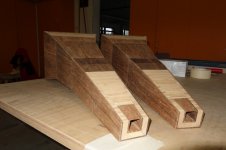 16143782_1986723731554993_4038804089980901666_o.jpg231.4 KB · Views: 405
16143782_1986723731554993_4038804089980901666_o.jpg231.4 KB · Views: 405 -
 16143567_1986723681554998_3092087589164440344_o.jpg190.1 KB · Views: 395
16143567_1986723681554998_3092087589164440344_o.jpg190.1 KB · Views: 395 -
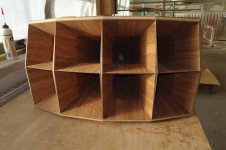 16700271_2005345186359514_5684327553369526837_o.jpg312.1 KB · Views: 386
16700271_2005345186359514_5684327553369526837_o.jpg312.1 KB · Views: 386 -
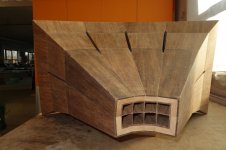 16722530_2005345466359486_170572685047661210_o.jpg291.9 KB · Views: 382
16722530_2005345466359486_170572685047661210_o.jpg291.9 KB · Views: 382 -
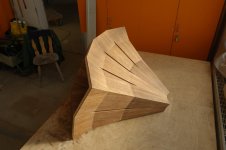 16797814_2005345369692829_208892861669365987_o.jpg184 KB · Views: 150
16797814_2005345369692829_208892861669365987_o.jpg184 KB · Views: 150 -
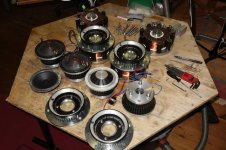 17311219_2024487294445303_6772836501335865711_o.jpg359.8 KB · Views: 174
17311219_2024487294445303_6772836501335865711_o.jpg359.8 KB · Views: 174 -
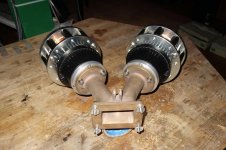 17358509_2024487254445307_1975720429001264264_o.jpg344 KB · Views: 547
17358509_2024487254445307_1975720429001264264_o.jpg344 KB · Views: 547 -
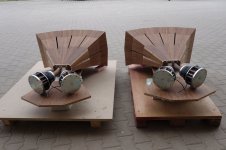 17434771_2027720814121951_8814925753866480746_o.jpg419 KB · Views: 178
17434771_2027720814121951_8814925753866480746_o.jpg419 KB · Views: 178 -
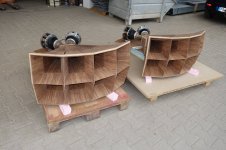 17309999_2027720854121947_9206394992801934700_o.jpg532 KB · Views: 184
17309999_2027720854121947_9206394992801934700_o.jpg532 KB · Views: 184
Someone one once suggested a place online to get all my wood from, as well as, have them cut to order....I don't know if I can find it again in the thread....otherwise I think its time to see who can cut my wood for me in my area.
B&C DCM50 converted to field-coil by Wolf von Langa.
A flange was made to attach the drivers to the Altec dual throat adapter.
A flange was made to attach the drivers to the Altec dual throat adapter.
Since it is quiet here, I drop some proper dual manifold horn porn.
I see some mechanical parts photos but there is no porn at all.
Where is it ?

I don't understand at all.Come on silversprout, let the fetish run free 😉
I still don't understand at all.
Some of the folk around here get a bit too excited by inanimate objects 🙄😕
Sorry, but i'm a technical redactor since 20 years and i'm bored to read that my work is porn... i'm not a pornograph.Some of the folk around here get a bit too excited by inanimate objects 🙄😕
My wife hates it if someone refers to a car as sexy. I understand.
Now let's get back to the scheduled program.....
Now let's get back to the scheduled program.....
- Home
- Loudspeakers
- Multi-Way
- Is it possible to cover the whole spectrum, high SPL, low distortion with a 2-way?